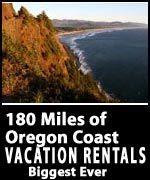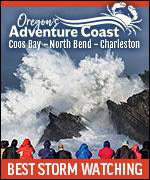Oregon Coast Relics Gone in Three Months Without Preservation Methods (Archived)
Originally Published 02/28/2008
By Oregon Coast Beach Connection staff
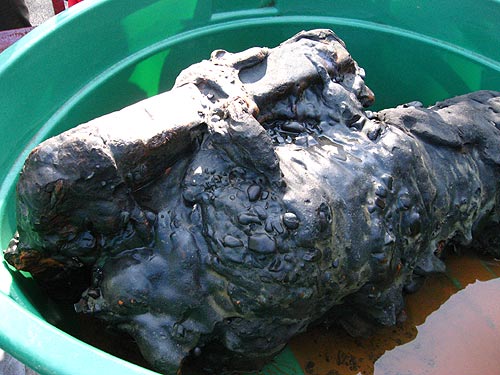
FROM THE OREGON COAST BEACH CONNECTION ARCHIVES: This story originally published in February of 2008 regarding the historic finds in Arch Cape that month and their temporary home at Nehalem Bay State Park. Photo above: one of the cannon sits in a tub at Nehalem Bay State Park.
Includes exclusive listings; some specials in winter
In Cannon Beach:
Includes rentals not listed anywhere else
In Manzanita, Wheeler, Rockaway Beach:
Some specials for winter
In Pacific City, Oceanside:
Some specials for winter
In Lincoln City:
Some specials for winter
In Depoe Bay, Gleneden Beach:
Some specials for winter
In Newport:
Look for some specials
In Waldport
Some specials for winter
In Yachats, Florence
Some specials for winter
(Nehalem, Oregon) – Oregon State Parks and Recreation held a special photo opp on Tuesday for media and some locals, showing off how they’re storing and dealing with the historic cannon that were found earlier this month.
A crowd of nearly fifty gathered at Nehalem Bay State Park at noon on Tuesday as state officials let media get a closer look at the two objects that have caused a stir around the nation, and explained a bit more about what will happen next.
Officials said it may take as long as two years to complete the restoration, and that without current preservation methods, they would fall apart in three months.
While officials like State Parks spokesman Chris Havel called their origin “possibly” from the same ship whose first lost cannon gave the north Oregon coast town of Cannon Beach its name – a tremendous historic find if proven to be true – they admitted the coincidences were striking. The official word is nothing is official yet, but even they are amazed.
“These were found in the exact same area as the first cannon,” said Shelley Parker of the parks department. She and other state officials note the dimensions of the first cannon exactly match these two new specimens, conceding that so far everything points to these being the two missing cannon from the USS Shark, from which the first one fell.
The Shark wrecked near the Columbia River in the 1840’s, a mere two years after it was launched to do surveys of wartime American shores during the Polk administration. Its cannon was found washed up in 1898 in what is now Arch Cape, a tiny village just south of the tourist hotspot Cannon Beach, giving the town its name.
That cannon is currently on display at the Cannon Beach History Center (corner of Spruce and Sunset in Cannon Beach. 503-436-9301).
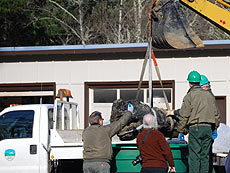 |
| Cannon is lifted into tub at a state park after being dug up from the beach (photo Chris Havel) |
The cannons are covered in a thick layer of natural concrete: the product of the metals working with the salination of the water over time beneath the sands. Havel said it will take a lot of painstaking peeling off of each layer. There are polished stones embedded in the concretion, and the shape of the cannon are barely discernible through the black casing.
“Estimates are this process could take six months to two years,” he said. The process could involve various chemical and even electrolysis processes.
Havel and Beach Ranger David Woody gave glimpses into what it’s taking to preserve these artifacts now. As Havel was talking about the various historical entities, state agencies and experts that would come together on this project, the plastic tarp was taken off the two large tubs containing each cannon in a slightly dramatic manner.
Woody said the objects have been buried beneath 10 to 20 feet of sand – the amount of sand that is currently missing from that area of beach because of massive winter storm action.
The cannon are immersed in fresh water and covered in burlap, to keep the parts sticking out of the water wet as well. This helps preserve them from corrosion and quick deterioration after decades of being in an oxygen-free environment.
“They would fall apart in three months without this method of preservation,” Woody said.
Once a week, the tanks are drained and then refilled.
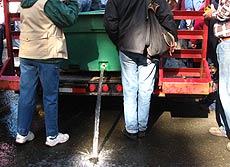 |
| Tub is drained of water during the press conference |
Havel said State Parks had to call on various cannon preservation experts around the country for advice on this. Now, the department has been advising some of the state archeological experts and preservationists. These groups will be meeting with local historical museums, such as the Columbia Maritime Museum in Astoria, and the Department of State Lands, putting together a team.
“We’re all going to work together to decide what the next step is,” Havel said.
Julie Curtis, with Oregon’s Department of State Lands, said her department has been meeting with state archeologists, State Parks and cannon experts – and they’re working very slowly. “We’re in new territory here,” she said. “We’ve never done this before. We’re learning as we go.”
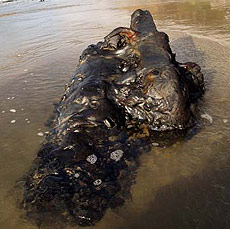 |
Cannon on the day of discovery in late February (photo Tiffany Boothe, Seaside Aquarium) |
The Department of State Lands technically owns the cannon because it was determined they were found on beach land under their jurisdiction.
The idea is to eventually put these on display for the public.
Parker talked about some of the more exciting developments since the cannon were found over a week ago. “One very big find was the presence of the wooden slides,” she said. These are the platforms the cannon were attached to so they could move during recoil from firing .
Also in the tub are chains from the cannon, which are covered in thick concretion as well, looking like giant, bulbous remnants from a barbecue. They are barely recognizable except for the minute chain links that are sometimes visible between the roundish objects.
Parker said the iron could start developing this concretion within a year of being immersed in sand. “Ironically, what had protected it before now causes further corrosion.”
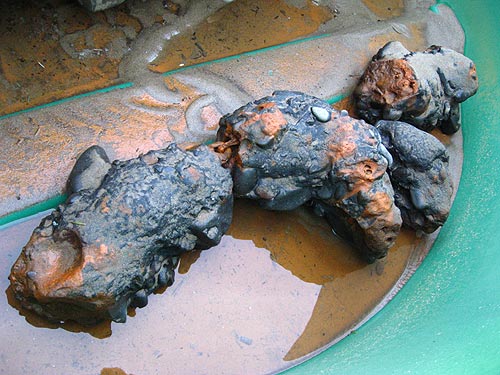
Even the chains of the cannon are encrusted in the concretion
When the USS Shark wrecked, none of its crew were lost, said Parker. The crew left an indelible mark in the Astoria area. They built a series of shacks to live in which were eventually called “Sharkville.” When the crew moved on, new immigrants to the area took over those shacks as dwellings.
The cannon are a type known as a caronnade, which wasn’t used very long in the first half of the 1800’s. They were more accurate up close, much less so far away, but they did pack a sizable, destructive punch. See more on the cannon in the books below and at the story Historic Oregon Coast Finds Get Attention from PBS Detectives
Cannon Beach Lodging
Nehalem Bay Lodgings
Manzanita Hotels, Lodging
Three Capes Lodging
Pacific City Hotels, Lodging
Lincoln City Lodging
Depoe Bay Lodging
Newport Lodging
Waldport Lodging
Yachats Lodging
Oregon Coast Vacation Rentals
Oregon Coast Lodging Specials
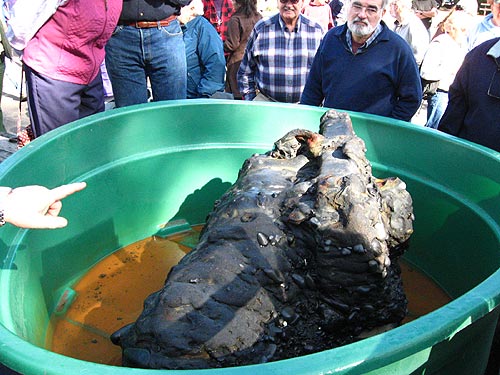
More About Oregon Coast hotels, lodging.....
More About Oregon Coast Restaurants, Dining.....
More stories on the subject:
Quick Facts About Oregon Coast Treasures, Geologic Wonders Much of the United States is focusing on the Oregon coast at this time, with various geologic developments and historic objects popping up left and right.
How To Find Oregon Coast Odd Discoveries, Artifacts If you want to play tresure hunter or geology explorer on the coast, here's a list of places to find the good stuff
The Science Behind Oregon Coast's Recent Treasures A big rush of unusual objects, some thousands to millions of years old, have been appearing on the Oregon coast. Here's why and how.
New Claims, Problems for Oregon Coast Artifacts and Oddities Artifacts recently found on the coast apparently have a new owner and some exceptionally strange tourist attractions may be in danger
Oregon Coast Relics Gone in Three Months Without Preservation Methods The now-famous cannon would fall apart in three months without current preservation methods, and restoring these could take as long as two years, officials said.
Treasures, Shipwrecks Create Huge Publicity for Oregon Coast It may be the biggest chunk of press the Oregon coast received since Keiko the Whale or the New Carissa shipwreck, and it's helping after the economic damage done by media coverage of the December storm
LATEST Related Oregon Coast Articles
Also: Hugh House back open for tours at Cape Blanco. South coast events
Historic N. Oregon Coast: Vintage Photos of Astoria, Bridges, Canneries
More pics turning up of the town's canneries, Old Young's Bay Bridge, Astoria-Megler Bridge
Coos Bay's Mingus Building Latest Oregon Coast Landmark on National Historic ...
Special Cabin Celebration Day on June 28. Coos Bay events, south coast events
From Oregon Coast Wild to Historical, Stark Changes of Seaside Aquarium Exterior
Drastic shifts in look and features dot the attraction's history. Cannon Beach history
When A Crusty Find Had Major Historical Implications for the N. Oregon Coast
Feb 2008 was a major discovery for Cannon Beach history
Remarkable Historic Photos from Oregon Coast With Even Wilder Tales
Cape Arago near Coos Bay, Astoria Column, blowing up Waldport's bridge, Wreck of the Iredale
Historic Details Pepper Hug Point's Road, to Millions of Years of Oregon Coas...
You'll see the old ruts dug into the rock. Cannon Beach
Rockaway Beach's South Jetty An Unruly Oregon Coast Historic Landmark
At the southern edges of Nehalem Bay, where the Nehalem River gets unusually intense
Back to Oregon Coast
Contact Advertise on BeachConnection.net
All Content, unless otherwise attributed, copyright BeachConnection.net Unauthorized use or publication is not permitted








